Hands of God and Adam (Wikipedia file photo)
The Pope Orders a Miracle
Pope Julius II believed Michelangelo could do anything and ordered him to decorate the ceiling of the chapel. “But I’m not a painter,” Michelangelo protested, “I’m a sculptor. I’ve hardly done anything with a brush and you want me to paint 2000 square feet on a curved ceiling!”
“You’ll do a great job,” said Julius. “I’ll have my architect Bramante set up the scaffolding for you.” He was a very tough man, more like a military commander than a pope, and he didn’t want to hear objections. Once he actually struck Michelangelo with his staff for impertinence.
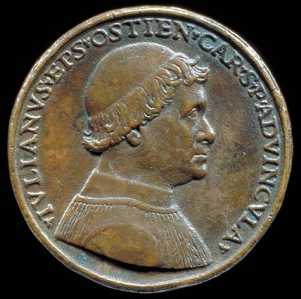 A medallion with the bust of Pope Julius II (Wikipedia file photo)
A medallion with the bust of Pope Julius II (Wikipedia file photo)
Michelangelo went home in despair. He was ambitious but the Pope was asking him to work a miracle. If he failed, all his errors would be on perpetual display. Yet how was he going to paint better than the painters?
The Great Design
Michelangelo considered his options. Though he had never painted in fresco, he would have to learn the technique, and his first design was simple: the twelve Apostles and some filler decoration. But soon he thought the ceiling was not going to look magnificent enough and he obtained permission for a more ambitious plan.
What Michelangelo then came up with was a vast painting of three hundred figures illustrating the pre-history of salvation—Man’s time on earth before the coming of Christ.
 Diagram of the paintings on the ceiling of the Sistine Chapel, Rome (Wikipedia file photo)
Diagram of the paintings on the ceiling of the Sistine Chapel, Rome (Wikipedia file photo)
What is fresco painting?
To paint on a wall old-time artists used a technique called fresco. They mixed sand and lime and spread the mix over the wall. Next they applied their colors but had to do it fast, while the wall was still wet or fresh. When it dried, the colors fused chemically with the lime and became permanent.
The fresco technique is old and dates back at least to the Egyptians.
It is not easy to learn. The spectacular portrait below representing Sappho, the Greek poetess, is Roman and was found under the volcanic ashes that destroyed Herculaneum, Italy.
Sappho, a fresco from Pompeii (Wikipedia file photo)
A Little Help from His Friends
For his frescoes Michelangelo made sketches called cartoons painted on canvas with watercolor. He knew about cartoons because he had made some for a fresco project in Florence. But he hadn’t actually copied them onto the wall, and he needed some expert advice. He wrote to his painter friends back in Florence and asked them to come to Rome and show him how to get started. They came very willingly and painted part of his first panel on the ceiling while he watched. But after only a week or two he realized he couldn’t do things their way and he sent them away.
He locked himself in the chapel and started, all alone, to copy his cartoons on the enormous vault of the Sistine Chapel. Trial and error. It was unbelievably hard.
The Physical Effort
Fresco painting requires real physical effort. Every day the artist has to mix up a batch of plaster and trowel it onto the wall, then hurry to finish his painting before the plaster dries. And painting a ceiling is doubly hard because everything has to be lifted, scribed, and painted above your head.
He stood on the wooden plank of the scaffolding sixty feet in the air and worked looking up. He rubbed and rubbed his neck, it ached so.
In a letter Michelangelo drew a little caricature of himself, reproduced below, painting a saint on the ceiling, his head bent back as far as it would go.
Michelangelo’s caricature of himself while painting the Sistine Chapel ceiling (Wikipedia file photo)
He drove himself to the limit. He practically lived in the chapel, eating onions and stale bread. “I have no friends and don’t want any,” he wrote his father.
The Great Setback
One day when he had completed about a third of the ceiling he noticed that a mold was forming on his paintings. That was the last straw. He ran to the Pope, asking to be allowed to quit the job. “I told you I wasn’t a painter,” he said. “Everything I’ve done is ruined.”
The Pope sent an expert to see what could be done and he showed Michelangelo how to remove the mold and told him to go on.
A Barrel Vault
The ceiling is a barrel vault with eight triangular indentations above the windows.
On those and the four corner triangles, called spandrels, Michelangelo continued his depictions of the ancestors of Christ and even covered the spaces farther down on the wall, the so-called lunettes, above the windows.
The Themes
In the middle of the ceiling were illustrations of nine Bible stories. The segment showing God creating Adam is one of the most famous images ever painted.
Other famous parts are The Flood and The Temptation and Expulsion from the Garden of Eden. The huge Jonah above the front wall is especially admired for its foreshortening, which had to contradict the curve of the ceiling to look right.
The nude youths framing those scenes, twisting and flexing with no apparent task, perhaps were meant to show Man’s futile struggle before Christ came.
God Creates Adam (Wikipedia file photo)
El Diluvio Universal (foto archivo de Wikipedia)
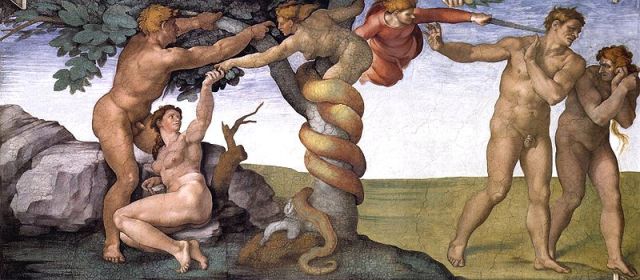 The Forbidden Fruit (Wikipedia file photo)
The Forbidden Fruit (Wikipedia file photo)
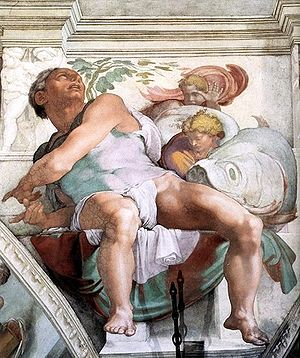
El Profeta Jonás (foto de archivo de Wikipedia)
The Impatient Pope
Pope Julius was so curious to see what Michelangelo was doing in the chapel that he would often drop in for a preview. He was awed by what he saw and he burned to show the paintings to his friends. Finally he became too restless to wait any longer for Michelangelo to finish. Besides, he was short-tempered and had never taken no for an answer.
Though only half the ceiling was covered, the Pope ordered Michelangelo to take down the scaffolding and open the chapel to the public. “I can’t,” said Michelangelo, “I’m not finished yet.”
He had been working for almost two years — from 1508 to 1510.
“If you don’t take down the scaffold I’ll have you thrown off,” said the Pope. It wasn’t meant as a joke. Michelangelo had to obey.
The Awestruck Public
The public crowded into the chapel and spread the news that the paintings were the greatest thing they had ever seen. The figures showed a new kind of beauty and power. Each of them was a masterpiece in its conception and colors. Michelangelo’s vision was overwhelming.
The Sistine Chapel ceiling paintings by Michelangelo (Wikipedia file photo)
Michelangelo set up the scaffolding again in January 1511. In a final surge of titanic energy he managed to complete the other half of the ceiling by August 14 and Pope Julius proudly celebrated the first Mass in his uncle Sixtus’ chapel.
There were still the spandrels and lunettes to be painted and Michelangelo didn’t finish those until October 1512. Altogether the ceiling was the work of fifty-four months.
Twenty-five years later another Pope would order him to paint the front wall of the same chapel. Michelangelo painted that great fresco, the Last Judgment, between 1537 and 1541.
Why is the Chapel called the Sistine?
The pope who hired Michelangelo was Julius II, famous as a warrior, a schemer, and a patron of Renaissance art. The chapel was built by Julius’ uncle, who was also a pope and was called Sixtus IV. In modern English the adjective became Sistine.
At the time the papacy was a top job reserved for the most influential, ambitious and clever members of the aristocracy.
Location of the Sistine Chapel in the Vatican
See this SPECTACULAR VIRTUAL VISIT to the Sistine Chapel. It is as good or better than a real visit (no crowds, you can get as close to the pictures as you want).
More on Michelangelo and other artists at The Best Artists
References
Most of what is known about Michelangelo comes from his letters, of which nearly 500 have survived, and from Giorgio Vasari and Ascanio Condivi, who wrote biographies while he was alive.
Both were friends of his and he read and commented on what they had to say about him. The two biographers knew and disliked each other.
The book by Ludwig Goldscheider is a prime source of authoritative information and a marvel of black-and-white photography.
..


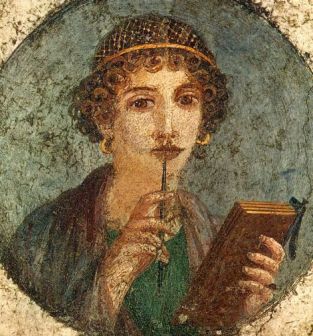
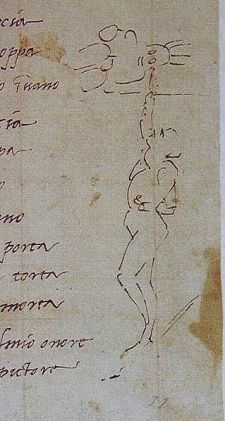
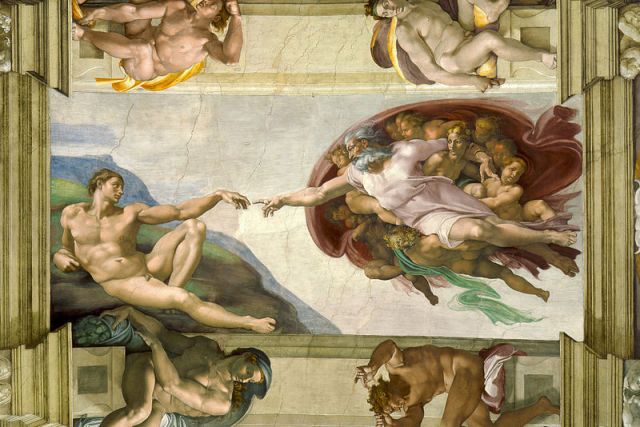
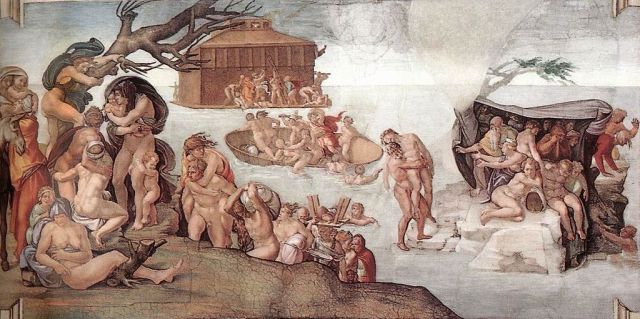

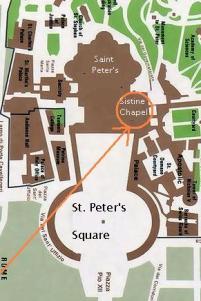


Pingback: Was Michelangelo the greatest content marketer of all time? - Re:signal
Stu@: All the information is in two biographies of Michelangelo by men who knew him: Vasari and Condivi. Read those. Vasari tells the “perfect circle” story about Giotto, not Michelangelo. You are right: go after the things that light you up but check, as you are doing here, to see if they are true.
Not sure when I was told this, maybe I read it years ago & stashed it at the back of my mind until now. Michelangelo got the job of painting the Sistine Chapel after he impressed the Boss by drawing a perfect circle free hand, but after reading this I’ve discovered he didn’t claim to be a painter & had to get a few pal’s around to start him off. There’s no mention of him needing to give a sample of his talent before he got the gig. Thinking I’ve misunderstood & over time got details mixed up but finding out everything through Google is too easy & life’s more fun with a few challenges along the way. Things that make a brain work must be beneficial so when I try to understand quantum mechanics or Life beyond on YouTube, mine should light up like a quasars. Back to the point, any like minded people ponder these things or shall I continue decorating with rubber wallpaper.
Pingback: イタリアの旅。。。バチカン市国の恐るべき実態② – 沖縄の外国風英会話教室〜Kerria(ケリア)
Style of this report is superb. The Pope’s insane commission could only have stemmed from a deeply entrenched faith in, admiration and respect of the artist’s supernatural capabilities.
this helped a lot for my project, thanks!
Thanks, cheesie. I still wonder how he sketched each of those great figures in his workshop and then dragged the heavy rolls of paper up the scaffolding of the chapel and copied them on the ceiling to such perfection. Vasari says the strain on his eyes wrecked his vision for months afterwards.
i like how you put the article together. it helped me visulize how it must have felt to piant like that.
thanks :) ;) XD
Pingback: ingenieurs marocains
Good article!
Pingback: The Art of Fresco | neccitaly
thank you very much!! rly appreciate the story!! all nicely done! ☆
Someone: Thanks for telling me–I’m glad it helped. Good luck on that presentation. Un saludo.
This was so helpful!!!! I have to make a presentation on this, and this article was by far the most helpful!!!!
Great article.
Thanks for teaching meh stuff thats cool to know. 😄 great article.
That was great
Its been my privilege to come across your article. Thanks for this wonderful article !!!
moist
Very helpful! Used it for help with my research and it provided me with everything i needed! Thanks!
Great help!
Animal Girl: And thank you for your comment. I’m glad it helped. Un saludo.
Thank you. Helped very much with my report for school. Great, trustworthy information with depth and detail. :-D
Thank you great article, managed to get to Rome last year and cannot wait to get back.
This month we have a special 3D movie coming to Dublin about the Sistine Chapel looking forward to that
Pingback: A Day in Rome: Michaelangelo, Raphael, and the Glories of the High Renaissance - Dreaming Beneath the Spires
Pingback: Quest for Joy-5: Michaelangelo and the Sistine Chapel. - Dreaming Beneath the Spires
Chloe: I don’t know whether your comment is an exclamation or a question. I know the Muslims do not allow images of God. I have seen a lot of Arabic art in Spain and never a human figure, only some birds and other animals. Most of it was very elaborate decoration: graphic flourishes and quotes from the Koran.
Dose this contrast with islanmic art
Pingback: Reconciliation in a Broken Church » When the Pope Ordered a Miracle
Pingback: Quest for Joy-5: Michaelangelo and the Sistine Chapel. | Dreaming Beneath the Spires
Catarina: Thanks for your comment. In fact, there are poems by Michelangelo that sound almost like prayers or at least acts of contrition. And what about that Florentine Pietà with the self-portrait? Reading Hirst’s latest book, I begin to wonder how wrong many of the traditional stories about him are. Hirst shows that he wasn’t a loner, that he had helpers in the Sistine, that he wasn’t so mistreated by the popes: he himself was responsible for the messes he got himself into by taking on too many commissions, for example. Nor was he such an unbelievable painter before taking on the Sistine Chapel. Yes, Julius made him paint the ceiling, but not long before that he had willingly accepted the job to paint the battle frescoes in the Palazzo of Florence.
In response to some comments- Michelangelo was actually never a religious man to extremes. He often DID make “pagan” god works (some just as famous) and placed many jokes in the sistine chapel, so I assume he never meant for it to be “spiritually uplifting”.. He was just painting, that was his job (that he was FORCED INTO) . He also practically painted it by himself. Very nice article, but to answer all questions you should go look at more.
I saw the Sistine Chapel and was not impressed. It was not spiritually uplifting. In fact it was
very sensual and reminded of pagan gods and goddesses. It is a great work of art and I found no spiritual value in breasts, backsides penises and fat angels.
I went to the link for the Virtual Sistine Chapel and all I can say is WOW!!! Having heard of this all my life, knowing I’d never go to Rome, and now being able to virtually stand inside (though dizzyingly) I have no words to do it justice. I am in awe. I had heard people become overwhelmed by all the artwork and statues when going to places like Rome, I understand that now too. Good article and thanks for the link!
Pingback: When the Pope Ordered a Miracle « Lutheran/Catholic
Geloruma: Thanks. Both his biographers (and friends) say that after telling those fresco painters (not apprentices but pros) to go back home, he did the rest all by himself, but no one believes that. They don’t mention any discussions with the theologians but there might well have been some. The Council of Trent ordered the covering up of the naked parts in the Last Judgment fresco (front wall) but there was never any “dressing” of the figures on the ceiling. Pricking holes in the paper was a typical way to transfer the cartoon drawings, and he might have used that method too, but he also scribed the outlines into the plaster with a stylus, as one can see on the pre-restoration photos.
DB: Wiki says:”The ceiling of the chapel is a flattened barrel vault springing from a course that encircles the walls at the level of the springing of the window arches. This barrel vault is cut transversely by smaller vaults over each window, which divide the barrel vault at its lowest level into a series of large pendentives rising from shallow pilasters between each window.” I’m glad we can see this and don’t have to figure it out from the description! It’s true, Michelangelo seems to have exaggerated the hemispherical look.
Nice post but it sounds like he painted it entirly by hemself; no mention of his assistants and his apprentice painters that helped. Also the ideas for the chapel came about as a result of discussions Michaelangelo had to have with Vatican theologians, as the scenes had to be theologically correct. ( I beleive a lot of the draperies were added later.)
The cartoons wre transferred by way of pricking holes in paper and punching charcoal through.
Excellent article! But I thought the amazing thing about the Sistene Chapel ceiling was that it was painted on a flat surface to appear to be a vaulted ceiling?
Pingback: A Day in Rome: Michaelangelo, Raphael, and the Glories of the High Renaissance | Dreaming Beneath the Spires
Iain: Thanks again. I was glad to hear about that book. You’ve made me curious to see those corrections on the ceiling frescoes and you’ve even had me toying with the idea of doing some fresco painting myself, as you did. I still have to get to Rome and see the “new” Sistine and decide for myself on the restoration job.
Yes, I didn’t mean to criticise – it’s very hard to write about such a complex undertaking in such a concise way. The restoration was actually quite careful: they were able to identify what he painted a secco, and left that intact; I was suprised to see many changes on the Libyan Sibyl for example, which was one of his last figures there. Clearly he needed to enlarge the head, the thumb, the foot, and some of the drapery. It wouldn’t have shown at the time, and even now is very hard to see.
I started to do some fresco myself recently which mankes me appreciate what he did even more. Up close, it’s very hard to judge the appearance of things and how they relate to other elements; it all has to be worked out in advance, and it’s no time to improvise. The Delphic Sibyl actually has a knife mark right down the middle and across the eyeline, like a giant X – and from a few feet away you can’t see it! But when you paint and adjust the details, the lines tend to move, and something like that keeps them where they should be. yes, look out for that book; you would probably find what the restorers say, and the respect they had for the work, quite fascinating!
Iain: Thanks for the comment. Of course both of his biographers said he did the job alone, which no one ever believed. I still haven’t seen the documents Hatfield dug up or read how he interpreted them, but it does seem strange that they were unknown to all the biographers until now. That Michelangelo let stories like this one (that he worked alone) circulate is no revelation, nor that he got rich, though Vasari expressly says he turned down that big salary from Pope Paul III. (“It is true that the Pope had previously granted him the toll for the river-crossing at Piacenza, which yielded about six hundred crowns, but he lost it when Pier Luigi died and was given instead a chancellery at Rimini, which was worth less and meant little to him. And though the Pope several times sent him money by way of a salary, he would never take it…”
Don’t forget to read Michelangelo’s letters, of which there are almost five hundred, and let him tell his own story.
I must buy the two volume book. I wonder how the cleaners justify their work. As you know, they removed some of Michelangelo’s al secco retouchings, such as the eyes on the Jesse figure. See my post at 100swallows and some of the comments.
http://100swallows.wordpress.com/2009/02/20/the-sistine-chapel-cleaning-job/
It’s a great article but just one point, and that is that his bank account shows he had a total of 13 various people on his payroll for the chapel ceiling over the 4 year period, and 8 of them were paid for the whole time. In fact, he would have needed a lot of help with pigments, ruling the pretend architecture and getting that boring stuff done while he worked away on the big figures!
I was very fortunate in buying this weekend a 2 volume set produced by the people who restored the ceiling over a 9 year period, and the vatican gave them access to everything known about michelangelo’s work, plus of course they were able to study the brushwork (and some of the mistakes over measuring etc!) and pigments used, in order to determine which bits were done in which order each day and the work of other artists helping out.
Pingback: Flash Fiction by Michelangelo Buanarotti « gurglewords
Maureen: Thanks for saying so.
Rachel Adams: Thanks.
This is a great article, I hope you don’t mind me pointing people who read my blog over to you.
good and interesting part of the sistine chapel (keep it up!!!!!!!!!!)
Sally: Thanks. Maybe you will find another article you like on Michelangelo and other artists at my other blog: http://100swallows.wordpress.com/
This really is a great article and It is not long but informative
It was a great pleasure to read this article
Thanks, Swimmy. One of Michelangelo’s biographers,Condivi, downplays Ghirlandaio’s contribution. Michelangelo was certainly with him for a short time (some months). His other biographer, Vasari, tells a story or two about his time with Ghirlandaio. He says Michelangelo drew the other apprentices while they painted. Ghirlandaio must have used him as a color mixer and general helper. It’s hard to believe that he let the kid paint but who knows. It is Vasari that says Michelangelo had never painted in fresco before undertaking the Sistine, which nobody believes, especially since he must have done a lot of practice in preparation for the Palazzo de Signoria mural.
Your article is really interesting, I enjoy how it’s broken down in to a way that’s easy to process. While you do highlight on cartooning projects Michelangelo worked on in Florence, above that you say he had never worked with fresco before. I thought Michelangelo apprenticed with the painter Domenico Ghirlandaio in his youth?
very VERY useful. great work :D
Eva: Thanks a lot. I’m glad I hit it just right for you. You make me wonder whether I ought to go over to my other blog on art http://100swallows.wordpress.com/
and rewrite a lot of posts to simplify and shorten them. I hope you can see the Sistine Chapel (and Rome!) some day. Un saludo.
This is great. It was interesting to read, but especially informative. Unlike other articles on such topics, this one wasn’t too long. Perfect length, catching key points. I didn’t know what the Sistine chapel was, which is why I read this. But thankfully, I learned what it is and how it came to be. I would love to see this place one day. It sounds delightful. Thanks.
WHy is the Sistine Chapel closed to viewers on August 14, 2010.
Great article